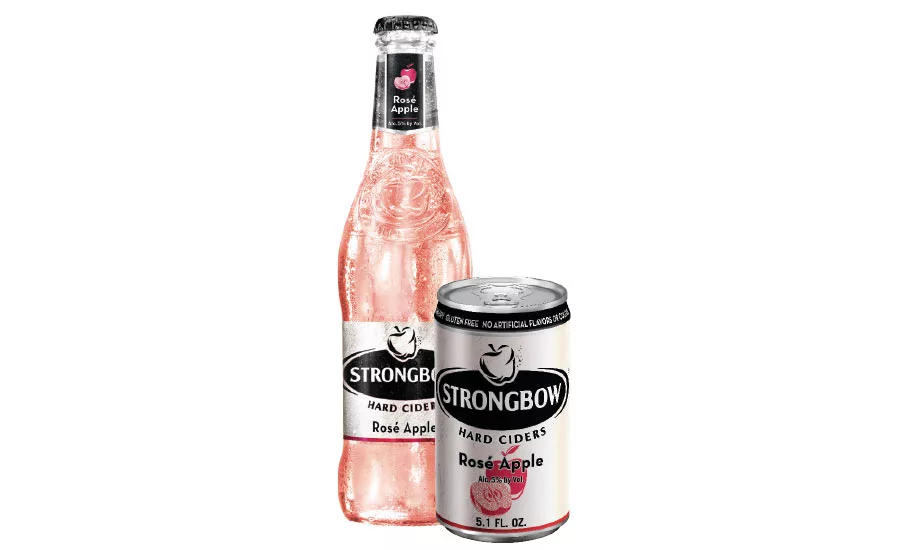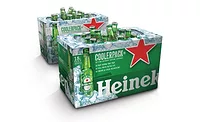Alcohol migration trends sparks innovation for HEINEKEN USA
Strongbow Rose Apple is driest hard cider in portfolio

Industry veterans and analysts are among the first to admit that consumers’ tastes have changed. Although much focus from mainstream media is geared toward the non-alcohol beverage market, the alcohol beverage market has not been immune to the shift in consumer preferences.
“According to IWSR, the U.S. beer market declined 0.5 percent in 2017, [and] total U.S. beverage alcohol con-sumption declined for the second consecutive year by 0.2 percent,” says Jessica Robinson, vice president of portfolio brands with White Plains, N.Y.-based HEINEKEN USA. “This loss is more than double that of 2016. The beer decline weighed down the performance of total beverage alcohol, where the growth of spirits (2.3 percent) and wine (1.3 percent) were unable to make up the difference in volume.”
Although beer sales in the United States have been down, the category still accounts for 79 percent of the total U.S. beverage alcohol market, based on IWSR data, Robinson explains. But, she also notes that not all of the news coming out of the beer category is bad.
“Total U.S. beer has been on a slow decline over the past five years,” Robinson says. “The paradox, however, is that by some measures, beer looks healthy. Imports have been trending up, especially Mexican imports, and the craft revolution has renewed interest in smaller brands with a plethora of styles and tastes; this has attracted a higher-end consumer to the beer category. We’ve seen the benefit to HEINEKEN USA’s premium portfolio, including Heineken, Heineken Light, Dos Equis, Tecate and Tecate Light.”
Although the import and craft beer segments have been a bright spot for the category, the beer market has seen macro trends contribute to the category’s overall decline during the past couple of years.
“The long-term trend of premiumization has contributed to the market share shift away from beer and toward spirts in particular,” Robinson explains. “According the IWSR, 2017 premium-and-above offerings currently comprise 33 percent of the spirits category and 22 percent of the wine category, respectively, compared to 12 percent and 2 percent in 1990.”
But beer manufacturers are not sitting idly by, instead they are helping to further the premiumization trend across various platforms and segments. “HEINEKEN USA is working to identify both subtle and overt shifts in consumer preferences,” Robinson says. “Premiumization and taste are both key to this effort. How can we as an organization bring innovation to the market that taps consumer demand for new, premium, unique, but at the same time fits within conventional alcohol beverage expectations, in terms of pricing, packaging and taste.”
Spectrum of solutions
As beer manufacturers are looking to tap into premiumization trends, they are recognizing the potential that can be realized from smaller, emerging beer segments.
Citing Canadean, Robinson explains that the cider category in the United States is about 1 percent of the beer market. By comparison, it stands at 4 percent in Canada and 22 percent in the United Kingdom, she adds. Citing a Goldman Sachs report dated Jan. 24, 2017, she also highlights that the financial services firm is forecasting cider to return to growth in 2019.
“We see this as an interesting trend on which to capitalize,” Robinson says.
In fact, Robinson notes that the hard cider segment is among HEINEKEN USA’s strategic growth objectives for the next five years, playing a key role in helping the beer manufacturer combat alcohol migration. She adds that the company views wine as a bigger challenge to the hard cider segment and is taking cues from those trends to support its cider brand: Strongbow.
“Watching what’s going on in the wine category, with growth being driven in part by a range of flavors and styles, we see an opportunity to extend the Strongbow portfolio to encompass a balance of offerings along a spectrum from sweet to dry, much like the wine producers,” Robinson says. “So, seeing what’s going on with Rosé wine, and how consumers approach wine selection, Strongbow will be introducing Rosé Apple positioned at the dry end of the spectrum to join Gold Apple, Cherry Blossom and Artisanal Blend.”
Available nationally, Strongbow Rosé Apple is semi-dry with a light, fruity aroma that is complemented by red-fleshed apples, the company says. Robinson adds that Rosé Apple is the driest hard cider within the brand’s spectrum of varietals.
“This gives us an opportunity to attract wine drinkers who approach the wine category with this orientation,” she explains. “Now, they can find the same spectrum in a cider brand.”
The semi-dry positioning of Rosé Apple will open up more opportunities to reach wine consumers, but also will bring non-beer drinkers to the category, Robinson says.
“Strongbow Rosé Apple is a wine-inspired line extension, targeted to wine drinkers in general and Rosé drinkers in particular,” she explains. “According to Kantar TNS, [fiscal year] 2016, we know that 66 percent of wine drinkers ages 22-39 who try cider become cider drinkers, with 36 percent becoming monthly cider drinkers.”
To encourage consumer trial, Rosé Apple will be available in 5.1-ounce limited-edition mini cans this spring and again in the fall, which will provide consumers with a low-cost opportunity to sample, Robinson notes. It also will be supported with in-store messaging titled “A Fresh Way to Reunite” that will be delivered at shelf and display point-of-sales materials as well as via social media. BI
Looking for a reprint of this article?
From high-res PDFs to custom plaques, order your copy today!





